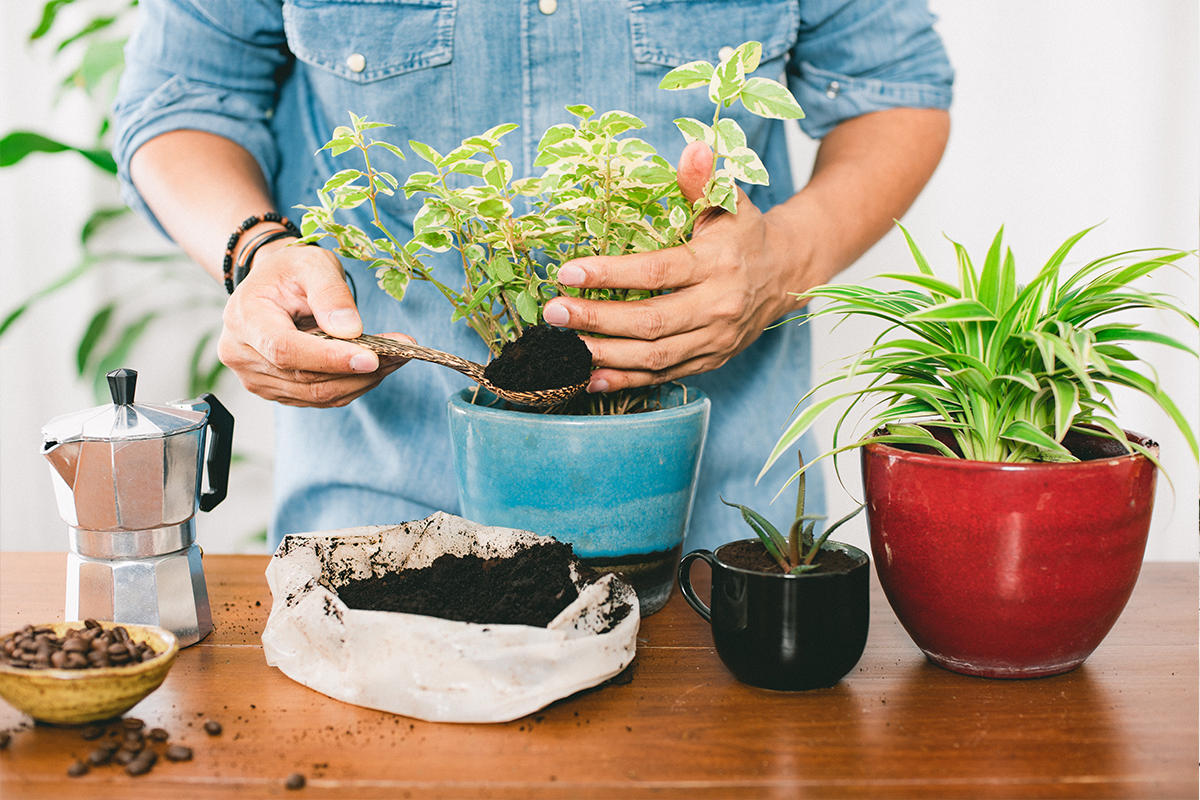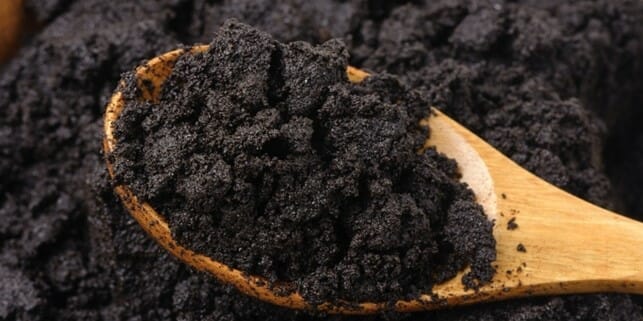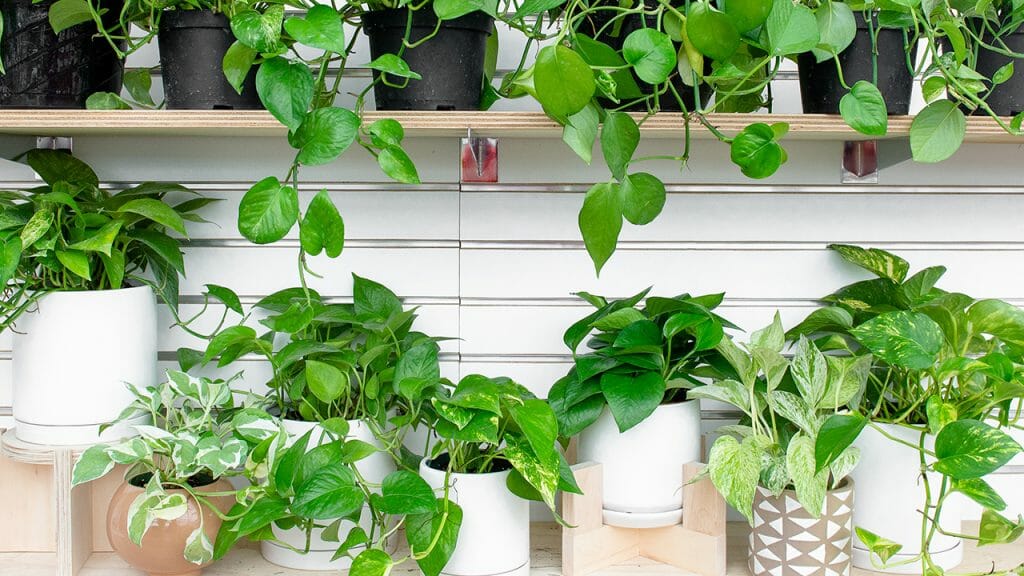While coffee grounds can provide some benefits for your plants and their soil structure, much of what we know regarding the benefits of coffee grounds appears to have spread by urban legend, not scientific proof.
You’ve heard the rumors before – used coffee grounds prevent slug and insect attacks, plant disease and they provide a variety of other nutritional benefits to house plants, including nitrogen, calcium, potassium, iron, and phosphorus, to name a few.
So, are coffee grounds for plants? Research shows that fresh, spent coffee grounds can suppress plant growth; therefore, I wouldn’t recommend you use them on your plants. However, if you use them, only do so in tiny doses, covering no more than half an inch.
Benefits of Coffee Grounds for your Houseplants
One significant supposed benefit is that coffee grounds contain high nitrogen levels. Though they may have high-enough nitrogen levels to support seed germination, it is often insufficient for noticeable benefits when used on plants.
Additionally, there’s a common misconception that coffee grounds are a reliable way to increase soil acidity. This, too, is not the case.
Coffee grounds have a neutral pH value. At a pH level of 6.5 to 6.8, they’re generally not going to increase your potting mix’s acidity level.
Now that we’ve gotten some negatives out of the way, there are still good reasons for using old coffee grounds with your plants!
Improved Water Retention
An experiment conducted in the Mediterranean found that when coffee grounds were added to agricultural soil, water retention stayed between -33 to -1500kPa.
Keeping your plants happy and properly watered is never bad, so that’s one win for coffee grounds!
Occasionally, indoor plants fare better in potting soils that drain easily. If too many coffee grounds are used, soils could turn soggy, leading to other problems such as root rot.
Adding organic matter, such as coffee grounds, can improve soil’s particle binding ability. This aggregation of particles is essential to the soil’s water-holding capacity.
Slow-release Fertilizer
As organic matter, coffee grounds decompose to release nutrients slowly. Their nitrogen (2.1% by volume), phosphorus (0.3%), and potassium (0.3%) provide nutrients that eventually support healthy plant growth, so coffee grounds as a fertilizer for houseplants is a legitimate technique.
That said, it’s important to remember that although they provide nitrogen, it is not immediately in a plant-available form.
Nitrogen only becomes available over time as microbes break down the coffee granules. On the other hand, phosphorous and potassium are available for immediate uptake by your plants, so there is a bit of instant benefit.
Manganese, iron, calcium, and zinc are also slowly released as the coffee granules break down. Calcium and magnesium are available to plants even with fresh grounds that have yet to break down.
It is essential to mention that even as coffee decomposes, these spent grounds may contain trace amounts of caffeine, which can actually slow plant growth—just something to keep in mind.
Improved Soil Structure
Coffee granules’ small size and compacting nature can lower soil bulk density.
A high bulk density (1.6 g/cm3 or more) hinders root growth. Mixing in grounds with your potting mix helps increase the soil’s compaction. Potting mixes with sandy soils can thus benefit from a lower bulk density.
It’s important to note that nitrogen in the soil becomes unavailable to plants as microbes decompose the ground because microbes, too, consume nitrogen. You can mitigate this by adding granules to the mulching layer instead.
Coffee grounds can also increase microorganism activity in the soil.
Recommended use of Coffee Grounds for Houseplants
Much of the research, observations, and experiments thus far have yielded conflicting results. Even so, most agree on the following uses for coffee grounds:
Mulching
Lightly sprinkled on soil with other materials such as straw and grass clippings, coffee can break down above ground without draining away nitrogen from plants, as would happen if directly incorporated into your potting mix.
Using them alone is not recommended, as their particles are quite fine and tend to clump together. This could result in a solid layer that prevents water from reaching your soil.
Hot Composting
One of the most highly recommended uses of coffee grounds is adding them to your compost bin. They are considered to be a green composting material due to their higher nitrogen content.
Together with your other kitchen scraps, these can be combined with brown composting materials (coffee filters, sawdust, dried stalks) in a 2 (green):1(brown) ratio for great compost that can provide better nutrition for your houseplants.
When used in compost, old grounds can also assist in the absorption of decomposing odors.
On the other hand, any powerful odors during composting signify that you probably added too many green composting components.
Vermicompost
Where outdoor hot composting cannot be done, vermicomposting can be practiced, as it can be done indoors.
It also takes a third of the time that hot composting does. Worms consume small but coarse granules to assist in their ability to digest food. Bacteria that break down coffee granules also assist the worms with digestion. Like plants, worms do not like too much coffee in their composting mix.
One experiment discovered that composting systems with coffee grounds had a higher earthworm mortality rate. Similar systems that included cardboard in their mix had a lower mortality rate.
It was concluded that this was a result of lower exposure to organic compounds that were given off as the coffee grounds were broken down.
Coffee Loving & Hating Plants
Which plants are coffee grounds best for?
Coffee grounds are best used with acid-loving plants. This includes blueberries, cranberries, azaleas, rhododendrons, hydrangeas, and hibiscus.
But they can also be used on other herbaceous plants, such as roses and vegetables.
What plants do not like coffee grounds?
Most vegetables, herbs, and flowers are not adapted to the acidic environment provided by coffee grounds. For these plants, composted manure is a better choice.
It is also recommended that you avoid using coffee grounds on alkaline-loving plants such as lavender, geraniums, and many succulents. In addition, some plants may be sensitive to caffeine, so it is best to test a small area of the plant before adding large quantities of coffee grounds.
Tips when using coffee grounds on houseplants
- If you rely on the coffee grounds you’re creating yourself, it might be a while before you have enough to use effectively. Store the spent grounds in an airtight container and refrigerate them, or else the grounds will likely develop mold.
- If you intend to utilize coffee grounds, spread them sparingly, and be sure to break clumps while spreading. Clumps can compact, preventing water from seeping into the soil. It should, therefore, not be used as the sole mulching material.
- Before use, research the compatibility of your plants with coffee grounds. They’re known to inhibit the growth or germination of some seeds and plant species. For example, lettuce grown in agricultural soil mixed with coffee grounds showed signs of inhibited growth.
- When using coffee grounds in compost piles, consider adding toilet paper rolls. These add the much-needed aeration to your pile and prevent excessive compaction that would be present due to coffee granules.
- Compost piles that turn brown too quickly imply that there is too much carbon present. In such cases, ground coffee is an excellent addition. Due to its fine nature and low carbon content, coffee decomposes quickly and does not result in foul smells, as would most green composting materials.
- Apply nitrogen-rich fertilizer to your plants should they begin showing signs of nitrogen deficiency, such as pale green leaves or stunted growth. As we mentioned before, coffee grounds do not contain sufficient nitrogen to promote higher levels of chlorophyll.
Frequently Asked Questions:
Can coffee grounds add acidity to my soil?
The acidity in ground coffee is water-soluble. Therefore, most of its acidity does not make it to the spent granules. As stated, used grounds only have a pH level of between 6.5 and 6.8, which is neutral.
Can spent coffee grounds repel insects?
Though caffeine in concentrated levels can help lower pesky insect infestations, ground coffee has much lower caffeine levels than would be required for a robust defense.
There isn’t sufficient evidence proving that ground coffee can serve as an effective insecticide. And areas with pets that frequently swallow dirt from your houseplant container may need to take extra caution, as this may affect your pet’s health if some of the granules contain caffeine, which can be toxic to animals.
Do ground coffee granules suppress disease in houseplants?
Studies have shown that when coffee grounds are used in composting, they appear to suppress pathogenic fungi from growing. Decomposing grounds stop some wilt and fungal rot species, such as Sclerotinia, from emerging.
This has been attributed to Pseudomonas, pin molds, and other non-pathogenic fungi and bacteria that appear when coffee grounds break down. However, these results may be difficult to replicate in practice, and caution should be exercised when not in a controlled environment.
Conclusion
Essentially, coffee grounds may lead to unwanted results when directly applied to houseplant potting soil. Their fine nature causes them to aggregate into tight clumps that may cake up around your plant leading to less water in the root system.
When mixed with soil in large amounts, these granules can cause increased moisture retention, which may cause fungal retention.
It’s not all bad, though, and when used in small amounts or broadcasted over your mulch, coffee grounds can provide a slow-releasing fertilizer for plants. Additionally, they incorporate with your soil to improve its structure as they break down.
Still, as a free source of fertilizer, they’re best used in hot composts or vermicomposts. Use plenty of caution and do your research to make sure that your plants will be happy and healthy in coffee ground-mixed soil.
At the end of the day, while coffee grounds can provide some nutrients, they’re not a miracle fix for your soil.
Many of the benefits take a while to access; even then, it may not be worth the time and effort. We hope this guide provides some proper insight!





